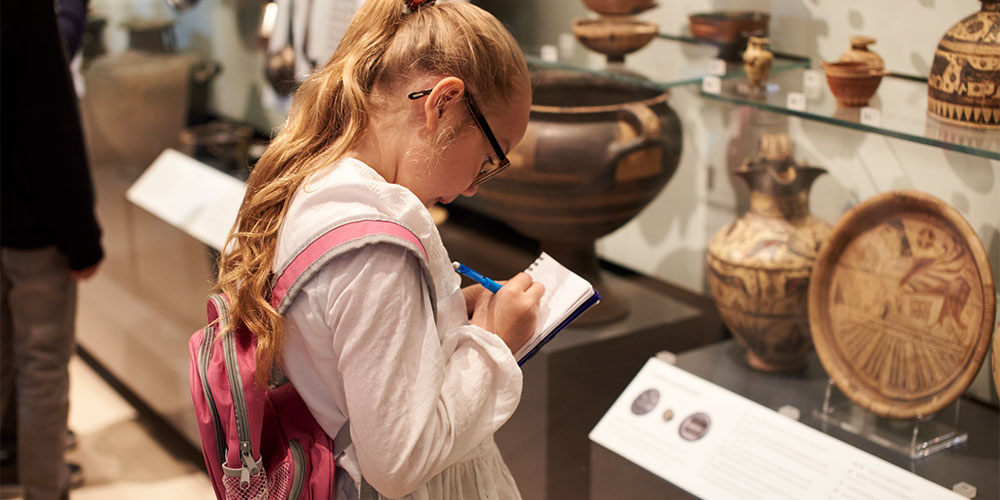Art history is about more than just learning the different art techniques used over the years. With the right strategies, art history can offer a lens into past cultures. What was important to the people of the past? How did they express themselves, and how has that changed throughout time? Art history provides us with a chance to connect with artists and previous cultures by helping us understand the art they created and why.
As educators, how can we engage students with art history and help them tap into that connection? How can we help them better understand how artistic expression illustrates aspects of these cultures and the self? Let’s discuss a few strategies and teaching resources that will help answer these questions.
Teaching History With Art
When teaching the history of art, it’s impossible — or at best, dull and shallow — to do so without teaching the context that surrounded art throughout history. Art is often a reflection of the world around the artist, and audiences viewed it through the lens of that world. Not knowing the right sociocultural context can alter how we interpret historic art.
As a 2021 art history timeline from Invaluable states:
The foundation of art history can be traced back tens of thousands of years to when ancient civilizations used available techniques and media to depict culturally significant subject matter. Since these early examples, a plethora of art movements have followed, each bearing their own distinct styles and characteristics that reflect the political and social influences of the period from which they emerged.
In prehistoric times, as well as in many ancient civilizations that did not rely on the written word, art was used to convey a story, express a warning, or record history. Many of the first alphabets — such as Egyptian hieroglyphic writing — were a string of images, and this type of script still exists in some cultures today, such as what we see with Japanese kanji. During the Middle Ages, the Northern Renaissance, and the Italian Renaissance, art was often used to spread religious or philosophical ideas. It could also denote power and status. Artistic styles played on top of each other. Romanticism gave way to realism, which then evolved into Impressionism and Post-Impressionism before transitioning to Expressionism and Surrealism. All of these styles —literal or symbolic, measured or chaotic, stoic or excitable — demonstrate the mindset of the people living during these various periods of history.
Understanding Composition
How has art been used to convey ideas, feelings, and stories throughout history? Much of it comes down to composition. Artists use the same tools today that they used hundreds or thousands of years ago, though they might now use them differently. Edutopia breaks down the composition of a painting into five distinct elements: color, framing, symbolism, body language, and lighting and shadow.
- Color: Artists have long used color to set the mood of their work. Bright colors, muted colors, and pastels all evoke a certain feeling, and across history, artists have used color to convey their reactions to certain people, thoughts, or events. Contrasts can also add to the mood of a work. Ask your class what colors call out to them in a particular work of art, and have them describe what they feel when they look at those colors.
- Framing: What’s going on in the background of a particular work of art? Is it day? Night? Is there a storm or clear weather? How do the various elements of the work of art draw the eye to a particular focal point, and is that framing trying to point out something specific about the work’s meaning or purpose? How did the historical context impact the framing of that piece, and how might we use another perspective to frame it differently?
- Symbolism: The use of symbolism can tell us something about the message the artist wanted to convey, as well as something about the meaning of certain imagery during a particular time period. Ask students to point out what pieces of imagery stand out to them, and have them explain what that imagery could stand for, given the full context.
- Body Language: What are the people in the painting doing? Are they smiling, laughing, crying, or shouting? Are they in a proud stance, despite a bleak background, or are they off in the corner of a crowded setting, crying? What — or who — are they looking at? Body language is one of the best ways to tell how a subject might feel in a work of art.
- Lighting and Shadow: Like color, manipulation of light and dark (chiaroscuro) can set the mood of the picture. Based on historical precedent, we often associate light with goodness, hope, and optimism; we associate darkness with danger, bleakness, and evil forces. However, some artists use these preconceived notions of light and shadow to subvert expectations. The truth is that a piece of art needs both light and shadow to have depth.
Art History as Celebration
This is a great time of year to engage students in art history, for a few reasons. February is Black History Month, and March is Women’s History Month. Of course, appreciation for the artistic accomplishments of Black and/or women artists can and should last all year. But, these two month-long designations offer a chance to catch your students’ attention and possibly help them find their new favorite artist.
A few artists you can highlight in the next two months include:






